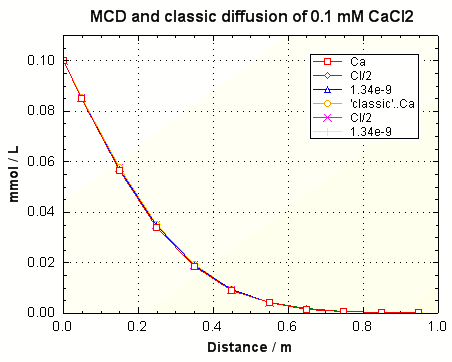
The porewater diffusion coefficient (Dp)
is related to the tracer diffusion coefficient (Dw) by:
Dp = Dw
εwn
where εw is the water filled porosity (-),
and n is an empirical exponent (~ 0.9 - 1.2, Grathwohl, 1998; Van Loon et al., 2007, but maybe higher for diffusion perpendicular to the bedding plane).
The parameter θ2 = 1 / εwn
is the tortuosity-factor, which expresses that the diffusion path in granular media, where grains must be circumvented, is longer than in plain water. Values for εw
and n can be entered with option -multi_d in the input-file.
We can compare the MCD and classic PHREEQC calculations. File mcd_ex2.phr
computes 3 years diffusion of 0.1 mM CaCl2
in a sediment with 0.1 ÁM KBr in the pores.
First with multicomponent diffusion:
-multi_d true 1.34e-9 0.3 0 1 # [true/false] [default_Dw / (m2/s)] [ew] [limiting_ew] [n]
where ew stands for the water-filled porosity (εw).
Then 'classic' with:
-multi_d false; -diffusion_coefficient 0.402e-9 # Dp = 1.34e-9 * 0.3.
The results are the same.

Note that PHREEQC assumes that all of the cell contains water and uses the porewater
diffusion coefficient for calculating diffusion. The effective diffusion coefficient (De)
is for a surface of grains and pores together, or:
De = Dp
εw
You can use option -stagnant for variable porosities, tortuosities and other
variations in the diffusion domain, defining the mixing factors among cells
explicitly in the input file. An example is given in
multicomponent diffusion of tracers in clays.